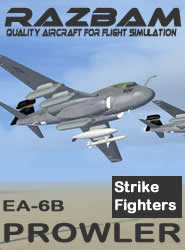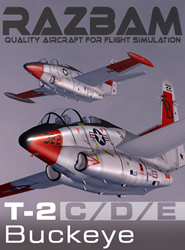
The EA-6B was a more advanced electronic warfare version of the A-6. Despite the fact that it used the same wing and fuselage configuration as the A-6 Intruder, it was in fact virtually a completely different aircraft. Consequently, it was given a new name--Prowler.
Despite its designation, the EA-6B was not a conversion of the A-6B, which was a defense suppression attack aircraft. Instead, the EA-6B Prowler was a four-seat electronic warfare aircraft designed to jam and deceive enemy radar and communications facilities. In later versions, it had the ability to fire HARM missiles against radar sites.
The first EA-6Bs were delivered to VAQ-132 in July of 1971. The squadron flew ECM support for aircraft carriers in the Gulf of Tonkin and the unit entered combat for the first time in July 1972 with VAQ-131 aboard the USS Enterprise. Two Prowler squadrons were active during the Vietnam conflict, and they carried out 720 combat sorties over North Vietnam. No Prowlers were lost in combat during this time.
The ICAP II was a further improvement to the Prowler. The last pre-production Prowler (BuNo 156482) served as the developmental aircraft for the ICAP II and flew for the first time on June 24, 1980.The ability to carry and launch the HARM antiradiation missile was incorporated with the 111th production article, and was retrofitted to earlier aircraft. The weapon's control panel was located at the right front navigator's position. Deliveries of the ICAP II Prowler began with the 99th production machine in January of 1984. All surviving ICAP I and ICAP Mod 1 aircraft were brought up to ICAP II standards.
The next phase was known as "Block 89A", and included an upgrade of 69 Block 82 and 56 Block 89 aircraft. The first of four upgraded Block 89A EA-6Bs flew at Northrop Grumman's St. Augustine, Florida facility on June 8, 1997. It is intended that the entire EA-6B fleet will be upgraded to Block 89A standards before the ICAP III modifications are made.
Third Wire�s Strike Fighters series versions includes:
EA-6B Prowler I-ICAP II
Desert Storm textures:
VAQ-139
VAQ-141
VMAQ-2
Custom sound set by Sky Song Sound Works
The A2F-1Q was an electronic warfare version of the A2F-1, initially designed as a replacement for the Douglas F3D-2Q Skyknight with the Marine Corps. The Marine Corps showed sufficient interest that they ordered the work to proceed in March of 1962. The aircraft was redesignated EA-6A in September of 1962.
Only 27 EA-6As were built, (2 prototypes, 10 modified from A-6A airframes, plus 15 production aircraft built from scratch as EA-6As). The planes served with the US Marine Corps in Vietnam as supplements and later replacements for the EF-10B (F3D-2Q) Skyknights. The first operational aircraft were delivered to VMCJ-1 at MCAS Cherry Point, North Carolina on December 1, 1965.
The aircraft retained a limited all-weather attack capability, although EA-6As were very seldom used for offensive operations. The aircraft could carry and launch the AGM-45 Shrike antiradiation missile, but this was very rarely used operationally.
The EA-6As were first deployed to Southeast Asia in October of 1966. The first twelve planes were equipped with the AN/ALQ-53 ECM system, plus an AN/ALR-15 radar warning receiver. Electronic jammers that could be carried included AN/ALQ-41, AN/ALQ-51, and AN/ALQ-55. AN/ALE-15 chaff dispensers could also be carried. On the 15 purpose-built EA-6As, the AN/ALQ-86 surveillance receiver system and the AN/ALQ-76 jamming systems replaced the earlier systems.
Third Wire�s Strike Fighters series versions includes:
EA-6A Electric Intruder South East Asia deployment:
VAQ-33
VMCJ-2
Custom sound set by Sky Song Sound Works
Available Options:
Version:









